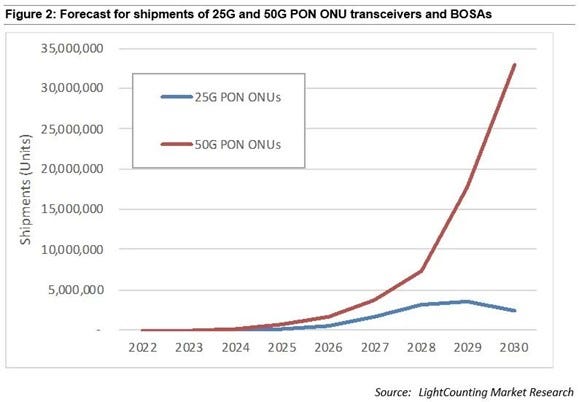50G PON Is the Future of Optical Access Technologies, According to a Report Released by LightCounting50G PON Is the Future of Optical Access Technologies, According to a Report Released by LightCounting
July 27, 2022

Recently, LightCounting, a market research institute in the optical communications industry, released a research report on the technology evolution path for the optical access field, 50G PON LOOKS LIKE A CLEAR WNNER VS 25G. In the report, LightCounting predicts the subsequent upgrade technologies of XG(S) PON based on the industry development history and characteristics, and believes that 50G PON has a better prospect than 25G PON in the future.
In the past 2021, global FTTx deployment had accelerated, thanks to the strong growth of 10G PON. According to this trend, LightCounting points out in another forecast report that the optical access market will continue to grow rapidly from 2022 to 2027. Currently, 10G PON has been deployed in most countries and regions. With the development of digital economy and the continuous digital transformation of industries, operators are now paying close attention to 10G PON evolution in the future. 25G and 50G PON have been considered as candidate technologies for future evolution of XG(S) PON.
In the analysis of 25G PON and 50G PON, LightCounting first points out that 50G PON has become an ITU standard in 2021, while symmetric 25G PON has not been standardized yet. Then, based on the characteristics of industry development, LightCounting analyzes the two technologies following three dimensions:
From the perspective of technology development history, based on the development comparison between 40GE and 100GE Ethernet and between 200GE and 400GE Ethernet, products with higher rates will be accepted by market users. Operators do not need to worry about bandwidth redundancy caused by high-speed access. With the development of the digital economy and the increase of network applications, users will definitely have higher requirements for network bandwidth and use high-speed bandwidth.
From the perspective of market influence, the choice of operators with higher market shares will define the development path of technology. Currently, fiber users in the Chinese market account for more than 70% of the world’s FTTH end users. Once fiber deployment is complete, the cost of upgrading networks to the next generation is not high. Therefore, the choice of Chinese operators will largely determine the development of the entire industry. China’s three major operators have chosen 50G PON as the evolution direction of next-generation fiber networks without exception. This choice will set the stage for the evolution of XG(S) PON.
From the perspective of technical cost, technical progress and large-scale rollout will bring rapid cost reduction in the future. Therefore, the application of new technologies should be evaluated not only based on the initial cost, but also from the perspective of development. Higher initial costs will not become an obstacle to the promotion of 50G PON in the future.
Considering the preceding three factors and historical data, LightCounting provides its estimation for future 25G PON and 50G PON ONU shipments.

LightCounting believes that with rapid deployment in China, the total shipment of 50G PON will exceed that of 25G PON from the initial deployment phase, and the difference will only become larger very fast in the ramp-up phase. China Mobile, China Telecom, China Unicom, and major European operators, such as Swisscom, Orange, and Telefonica, have chosen 50G PON as the evolution direction of optical access XG(S) PON. Currently, although some operators in North America and Europe may prefer 25G PON, the shipments are relatively small compared to that of 50G PON. Therefore, 50G PON will become a clear winner and take up the major market share.
About the Author
You May Also Like










.png?width=300&auto=webp&quality=80&disable=upscale)


_1.jpg?width=300&auto=webp&quality=80&disable=upscale)